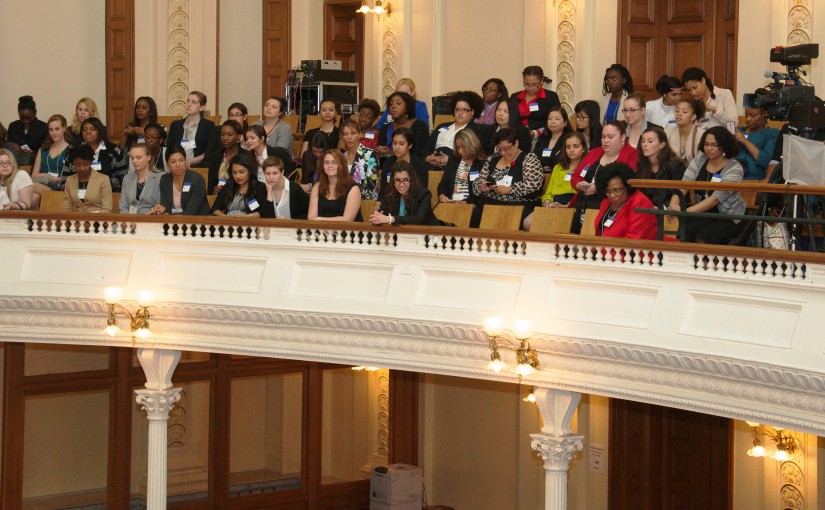Traditional Tours and Civics Lessons
A field trip to the state capitol is a great way to teach young people about government. Tours of state capitol buildings are typically available through the state’s official tour guide office. Please note, however, that many traditional tours emphasize the history and architecture of the building(s) as opposed to civic education. The ideal tour is one that focuses on the activities that occur in the halls of government. The goal of such tours is to teach students about the legislature’s role in representative democracy and encourage civic participation in the American political system. On such a tour, the students could visit the Governor’s front office, the Assembly/Representative/Senate caucus rooms, and voting chambers. A visit to a committee room may include a discussion of the role of committees in the legislative process.
The Center for American Women and Politics (CAWP) has done versions of the tour in the form of following a bill: at each stop the tour guide discusses what would happen with the bill as it travels from the Office of Legislative Services to each house to be voted on to the Governor’s office for signature. Some states offer such tours already to help students learn about the lawmaking processes and the various workings of state government.
ACTION STEPS
- Reach out to your state’s official tour guide service to see if a special civic education tour exists or could be created for your students.
- If they cannot craft one for you, obtain permission to create one and have it done by someone who understands the process and can teach it to students (check in advance to make sure you do not run afoul of security regulations or other rules regarding large groups.)
Making Sure Civic Education Tours Include Gender Lens
As noted above, tours of State Houses/Assemblies/Capitol Buildings can help all students, especially those in government, civics and history courses, learn about the lawmaking process. While these tours are educational in and of themselves, it is important to view them with a gender lens. Assuming that a basic civic education tour is available or could be created for your group, below are suggestions to weave information about women’s roles and leadership in state government.
ACTION STEPS
- Review the plan for the civic education tour and incorporate details about women’s history throughout, using the questions and tips below as a guide.
- Find out if your state has any special sections or exhibits on women’s history, and ask that it be included in your tour.
Legislative branch
Facts on women in state legislatures can be found here, and state-specific facts can be found here. Questions to consider on your tour:
- How many women currently serve in the state’s legislature? How does your state compare with others?
- Are there any women in leadership positions? e.g. Speaker, Majority Leader, etc. How many women currently head legislative committees?
- Who was the first woman elected to the legislature?
Executive branch
Facts on women governors can be found here (check your individual state’s page for details). Questions to consider on your tour:
- Is there currently a woman governor in the state? Have there been women governors previously (note how many, if any)? Who was the first woman governor (if applicable)?
- Are there women serving in statewide elected executive positions besides governor? (Note: every state has a different number of statewide elected executive positions. To find your state’s information on women serving, go here.)
- How many women serve in the governor’s cabinet? (Visit the current governor’s web page to obtain information about his/her cabinet).
Judicial Branch
Typical Capitol tours focus on the legislative and executive branches. Some tours also address the judicial process. Information about women in the judiciary by state can be found here (source: National Association of Women Judges). Questions to consider on your tour:
- Are there any women currently serving on the state’s highest court?
- How many women have served on the highest court?
- Who was the first woman appointed to the highest court?
- How many women judges are in the state currently?
Other Details or Points of Interest
- Make note of any important references to women leaders in the state buildings you tour, such as statues, portraits, and other details.
- For example, a sculpture in the New Jersey Statehouse incorporates symbols of the state: a red oak tree with honeybees, wild violets and Eastern goldfinches, which are the state tree, insect, flower and bird. Since it was commissioned during Governor Christine Todd Whitman’s administration, the piece even includes a ladybug for the state’s first (and so far, only) woman governor.
- Are there any special or ongoing exhibits that highlight women’s roles in government in your state?
- For example, the Ohio Statehouse features a special Ladies’ Gallery focuses on women who were important to Ohio history, in particular paying tribute to Ohio’s first six women legislators who paved the way for women in government. A special Women’s History Exhibition also focused on women suffragettes and Mrs. Florence Harding as the woman first legally able to cast a vote for her husband, presidential candidate Warren G. Harding. Film clips from the Ohio Historical Society show a suffragette parade in Marion, Ohio, and Mr. and Mrs. Harding voting in the 1920 presidential election. A web site was created to highlight the Ladies’ Gallery and offer ongoing resources on women’s political history in the state.
